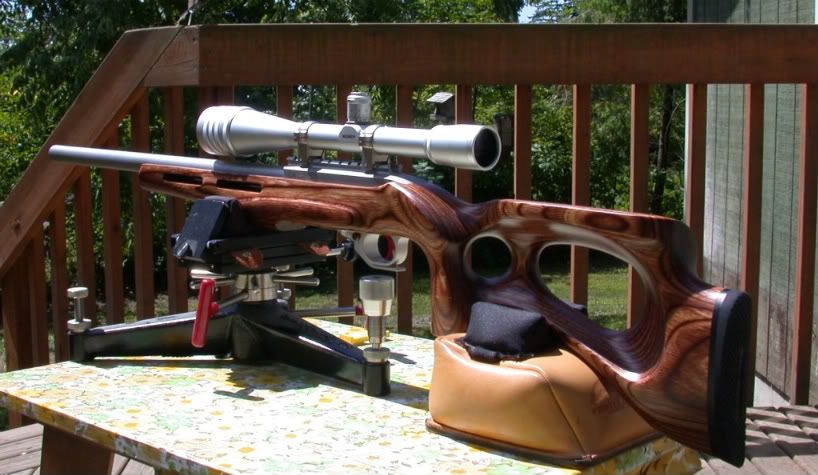Hi all,
Brand new to the forum and yes, this is my first post!
I've got a brand-new 10/22 T/D, and its the all-blued, "Tactical" model with the flash-hider. Love the gun, even more than my SR-22 rifle. Yes, its just a fun plinker, not a serious target shooter, but I do hope to maybe use it for some small pest control occasionally. So, I want to put a good optic on it!
I've done searches and read MANY threads about this topic and the challenges of finding a scope/optic that can stay on the gun yet also fit into bag that came with the gun. I'm not really interested in quick-release rings and having to remount my optic every time I go out to shoot, since they almost always add too much additional height to the optic, which I'm trying to avoid. I'm hoping to mount whatever optic I get as low to the barrel as possible so as to get optimum cheek weld and also ease of insertion/removal from the Ruger carry bag.
So, what am I looking at? Well, I was all ready to get the Leupold VX-1 2-7x28mm Rimfire scope with some low rings and call it a day. It seems to be a popular, albeit somewhat expensive scope, but its size is about perfect for this application. Nice clear glass, light weight, is suitable for rimfire with the appropriate parallax setting, and magnification flexibility with 2-7 power.
But then, while at the same shop, the guy behind the counter pulls out the new Vortex Spitfire 3X prism scope and shows it to me. What a cool optic! Ultra clear glass, a sharp reticle which is etched right into the glass (no batteries required to use, plus parallax-free), green and red illuminated reticle options, and has a removable riser so it can be mounted directly on the UTG picatinny rail that I put on my gun (so no need to buy a mount). The only downsides that I can see, are the fact that it still rides a bit higher above the bore than I would prefer (I would have to build up the cheek rest a bit for good cheek weld), its fixed magnification at 3x, and that its $100 more than the Leupold (but still would need rings for the Leupold). But wow, what a cool optic!
Yes, I know - the Vortex Spitfire 3X is marketed as for ARs specifically, and maybe someday I'll get one that I'd transfer it to. But for now, is there any good reason why I shouldn't consider it for my 10/22 T/D? I've searched this forum, and nobody is talking about this relatively new optic yet, so I thought I'd start the conversation.
So, what do you think? The Leupold VX-1 2-7x28mm Rimfire or Vortex Spitfire 3x?
thanks!
Brand new to the forum and yes, this is my first post!
I've got a brand-new 10/22 T/D, and its the all-blued, "Tactical" model with the flash-hider. Love the gun, even more than my SR-22 rifle. Yes, its just a fun plinker, not a serious target shooter, but I do hope to maybe use it for some small pest control occasionally. So, I want to put a good optic on it!
I've done searches and read MANY threads about this topic and the challenges of finding a scope/optic that can stay on the gun yet also fit into bag that came with the gun. I'm not really interested in quick-release rings and having to remount my optic every time I go out to shoot, since they almost always add too much additional height to the optic, which I'm trying to avoid. I'm hoping to mount whatever optic I get as low to the barrel as possible so as to get optimum cheek weld and also ease of insertion/removal from the Ruger carry bag.
So, what am I looking at? Well, I was all ready to get the Leupold VX-1 2-7x28mm Rimfire scope with some low rings and call it a day. It seems to be a popular, albeit somewhat expensive scope, but its size is about perfect for this application. Nice clear glass, light weight, is suitable for rimfire with the appropriate parallax setting, and magnification flexibility with 2-7 power.
But then, while at the same shop, the guy behind the counter pulls out the new Vortex Spitfire 3X prism scope and shows it to me. What a cool optic! Ultra clear glass, a sharp reticle which is etched right into the glass (no batteries required to use, plus parallax-free), green and red illuminated reticle options, and has a removable riser so it can be mounted directly on the UTG picatinny rail that I put on my gun (so no need to buy a mount). The only downsides that I can see, are the fact that it still rides a bit higher above the bore than I would prefer (I would have to build up the cheek rest a bit for good cheek weld), its fixed magnification at 3x, and that its $100 more than the Leupold (but still would need rings for the Leupold). But wow, what a cool optic!
Yes, I know - the Vortex Spitfire 3X is marketed as for ARs specifically, and maybe someday I'll get one that I'd transfer it to. But for now, is there any good reason why I shouldn't consider it for my 10/22 T/D? I've searched this forum, and nobody is talking about this relatively new optic yet, so I thought I'd start the conversation.
So, what do you think? The Leupold VX-1 2-7x28mm Rimfire or Vortex Spitfire 3x?
thanks!








